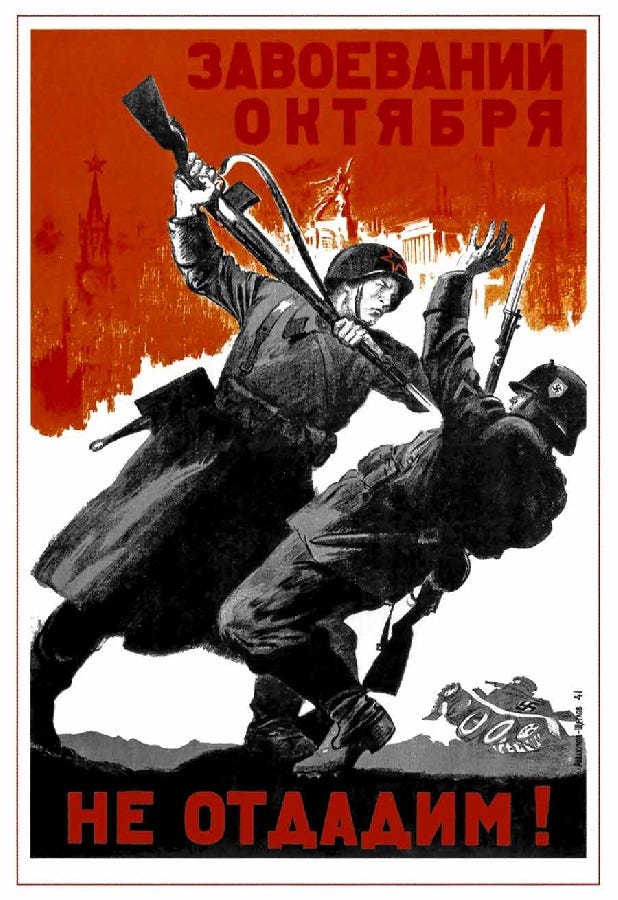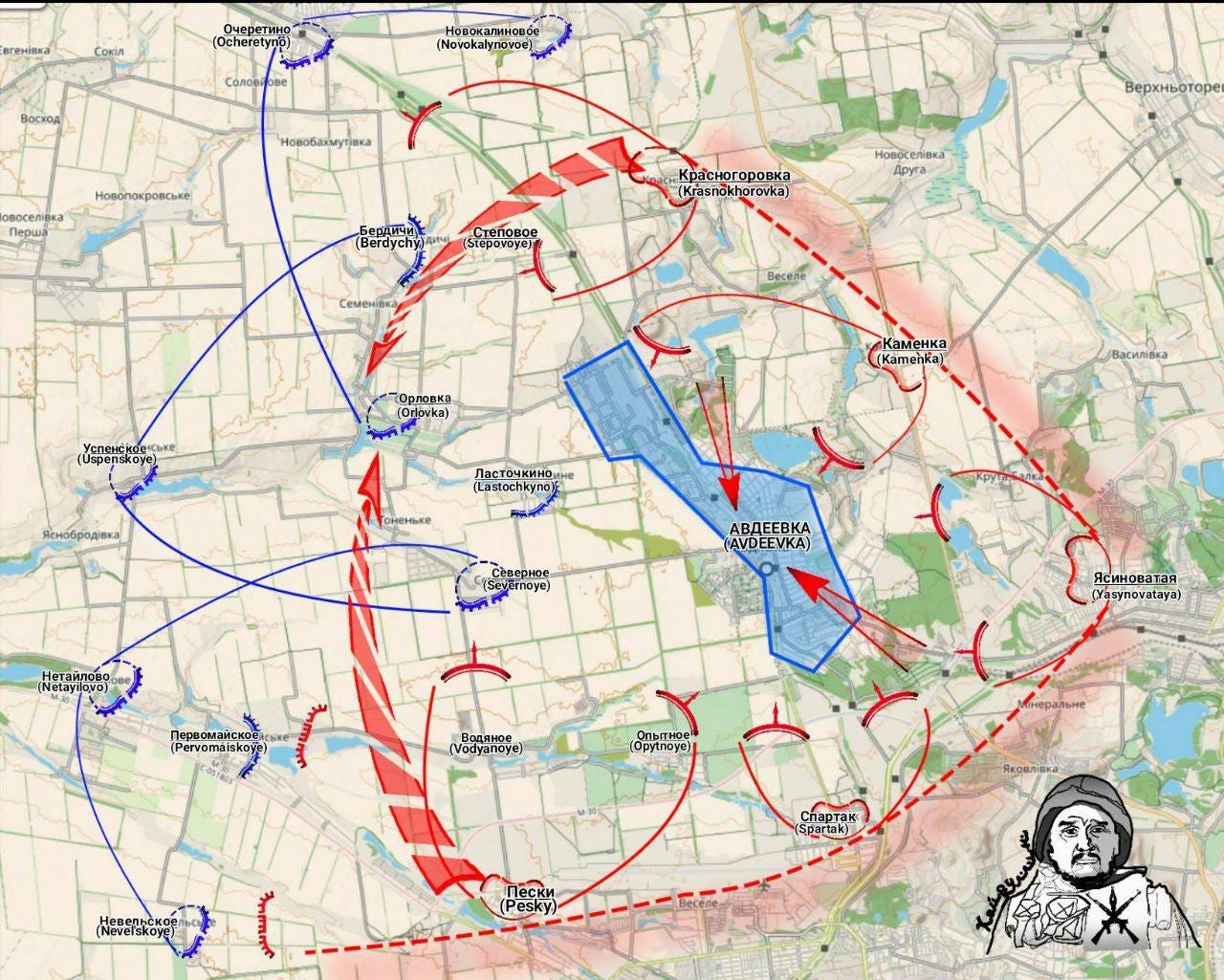In October, it will be exactly one year since the beginning of the large operation to break through the main fortified area of the Ukrainian Armed Forces - conventionally the Donetsk Front.
Bakhmut-Toretsk-New York-Avdeevka-Krasnogorovka-Maryinka-Konstantinovka-Ugledar - this was the first line of fortifications.
Chasov-Yar-Konstantinovka (the 2nd)-Pokrovsk-Selidovo-Kurakhovo - this was the second (reserve) line.
These fortifications were built and improved continuously for ten years. The total depth of the defense reached 50 kilometers. The first line was about 180 kilometers long, the second about 90. The territory of both lines combined included large settlements of about 400 multi-story buildings, which can also be successfully used as fortifications, and 1200 large industrial facilities (more than 200 mines alone), which in themselves also represent ready-made fortresses.
Let me remind you, here was a 450,000-strong enemy group, armed with the latest technology from Western allies. At the same time, we must take into account the logistics factor. Due to the shorter transport leg inside the arc of the thousand-kilometer front, the Ukrops could very quickly transfer reserves, and it was believed that they had at least 300 thousand people at the beginning of the Avdeevka operation. That is why they felt so confident even after the failure of the counteroffensive, they counted on sitting it out behind these fortifications.
Such a concentration of forces and resources has no analogues since the Great Patriotic War. For example, in 1945, during the Berlin offensive operation, in the offensive zone of the 1st Belorussian Front, which actually took Berlin, the Germans concentrated 23 divisions 175 kilometers wide - this with a total defense depth of up to 40 km.
It is believed that the German infantry division by the end of the war numbered about 14 thousand people, if so, then it turns out to be about 320 thousand soldiers here.
If we compare the amount of artillery, the First Belorussian Front in this battle was confronted by an enemy artillery group numbering about three thousand guns. At the beginning of the Avdeevka operation, the Ukrainians had almost 4 thousand guns in this area alone. They also used about 700 tanks.
Marshal Zhukov broke through the German defenses with 12 armies (including two tank and one airborne) and 4 tank corps. Interesting point: 2 of Zhukov's armies were special shock troops. Apparently, at least three shock armies have already been created in Russia, one of which is the 54th Guards Army based on the First Donetsk Corps, where my native “Slavyanka” serves. In addition, the concentration of artillery in the Berlin offensive operation of 1945 was 270 guns per kilometer of the front.
Let me remind you that the Avdeevka liberation operation began with the forces of two armies on a front width of about 60 kilometers (from Maryinka to Novobakhmutovka). Now, the enemy's first line of defense has been almost completely eliminated (battles continue only in Toretsk and Ugledar). Nominally, 10 of our armies (not counting separate corps and divisions with regiments) are working on the front line from Ugledar to Chasov Yar, three of which can be called "special shock troops." It is believed that the total number of artillery pieces in this area now exceeds 7 thousand. Plus, there are about two thousand tanks here.
The Air Force is a separate story. Three air armies participated in the Berlin operation of 1945 - approximately 6 thousand rotary-wing aircraft, not counting transport aircraft. We currently have 4 air armies working directly at the front. And another air corps is about to be activated. Experts believe that this is approximately 600 aircraft directly at the front, not counting transport aircraft and long-range aviation. At the same time, it is emphasized that the group is still only gaining momentum and is working at no more than a third of its real capacity - about two hundred to three hundred combat sorties per day. It is believed that a nominal frontline group of Su-34s (100 plus aircraft) can, in one sortie, without much effort, dump a thousand tons of bombs on the Ukrops, and at the same time, the average flight time of these machines is 4 sorties per day.
In addition to the planss, we must add approximately the same number of helicopter aircraft. In other words, we have a total Air Force group of about 1,200 units operating at the front. With a front width of a thousand kilometers, it is not difficult to calculate that we can give the enemy a fiery hell from the sky at any section. In general, the math is very simple: after a year of fighting, after the destruction of the first line, the length of the Ukrainian defense was reduced by about half (from 200 kilometers to 100 - I will immediately make a reservation, the numbers are very approximate).
On top of this, the concentration of our troops and firepower have increased. Already now, the number of artillery barrels in the Kurakhovo-Pokrovsk area exceeds 100 plus. At the same time, the Ukrops lost almost 400 thousand people in this battle, according to the Ministry of Defense, from October 2023 to October 2024. Specifically in this direction (from Bakhmut to Ugledar) - 250 thousand. In October, there is no doubt that Toretsk will be finally taken, and our troops will come close to Konstantinovka the second.
After the capture of Ugledar, the battle for the last line of the Ukrainian defense will begin. Here, the situation for the Ukrainian Armed Forces is very bad. In fact, the fall of Ugledar means the encirclement of Kurakhovo and the entry of our troops into the rear of the entire Pokrovsk group of the enemy. The same thing on the Northern flank - the capture of Konstantinovka (the one near Chasov Yar) opens the way to the rear of Pokrovsk. As soon as our troops approach Pokrovsk and Kurakhovo respectively, we will see new powerful attacks in the North and South. This is a breakthrough in Zaoskol between Kupyansk and Izyum, and a breakthrough on the line Velyka Novoselovka - Orekhov. That is, this is the formation of such a global cauldron for the remnants of the Ukrainian Armed Forces on our bank of the Dnieper.

In the current situation, the Ukrops need to begin a large-scale retreat to avoid getting caught in a global cauldron. But an army of such a size cannot retreat to nowhere - it needs pre-prepared positions in the rear. And the Ukrainian Armed Forces do not have such positions beyond Pokrovsk and Kurakhovo. This means that the Ukrops will most likely crowd into the cities and be destroyed remotely by our army. This is where the Russian air force, which has gained strength, will play its main role.
But that's not all. There are very high hopes that in October we will see the beginning of the second major operation to eliminate the next largest enemy group, similar to Avdeevsko-Pokrovskaya. This is a conventionally northern group in the area from Seversk to Kupyansk. There are about 200 thousand Ukrops here on a front width of about 150 kilometers.
We are already observing the first part of this operation - the exit to Zaoskolye. Our troops have reached the enemy's main crossing in the Sinkovka area. And, apparently, as soon as we approach Konstantinovka the second, the offensive will begin along the line Chasov-Yar-Kramatorsk-Slavyansk.
Let me remind you that in a straight line to Slavyansk (from the line of contact near the village of Minkovka on the E-40 highway) it is no more than 25 kilometers. There are no fortifications here, not even close to those near Toretsk or Pokrovsk. And Slavyansk itself is supported from the north by the Torsky ledge, which is very unpleasant for the Ukrops.
Our approach to Slavyansk will immediately complicate the situation of the Ukrainian Armed Forces on the Severskaya arc and in the Serebryansky forestry. In a word, we are rooting for our guys. October will be a very important month.
And finally, I remind you, the main narrative of the Ukrops, after the failure of the counteroffensive, was hope for the winter. Like, "No one fights in the winter, let's sit down on the defensive, rest, collect the scraps of our army." However, as experience shows, it is in winter that we fight best. It is no coincidence that the Avdeevka operation began in October - with the onset of the thaw. Today, the principle is the same - the Ukrop army is heavily bled dry, weakened. And throughout the year we have only increased our efforts, so it is logical that we will continue to act in the same paradigm. Press and only press, finish off the enemy who has already thoroughly sunk, and in this regard, the next offensive on the Kharkov front that began yesterday is very important. But we will talk about this separately.







Excellent article. I think its time that the Russians finish off their opponents which will hopefully bring the west to realise their folly of going against a nuclear superpower. This is a battle of attrition and the Russians have now built a momemtum which the other side cannot stop. Desperation is already unfolding in the west, what with the idiotic statements that come out of their mouths. Russia is teaching the combined west a lesson in strategy,operation and tactical application of all three. The timing of October 1st. ground forces day together with the October revolution is the perfect setting and timing for the offensive. Congratulations and best wishes to all of Russia for their immense sarifices the country has made. Hopefully it will be the last.
America needs this basic math lesson, since we don't do maps....which shows Russia on top of the world....